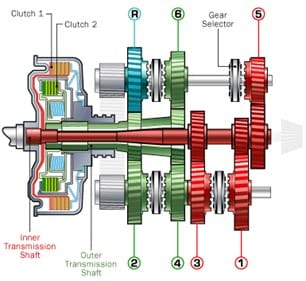The automobile industry is at the fore in adopting modern and advanced technologies. Dual-clutch automatic transmission is one such innovation that is making waves.
If you don’t regularly follow the auto industry, evolving transmission systems can seem a complicated subject. Over the years, various broadcasting systems have made it to the market. Manual transmission has been around for the longest time. However, it is not easy to drive and this forced the automakers to look at alternatives.
One such option is the dual-clutch automatic transmission. Before you buy your next car, learn about dual-clutch automatic transmission and understand if it’s for you. Let us learn more about this transmission system!
What is Dual-clutch Automatic Transmission (DCT)?
Dual clutch automatic transmission is also called direct shift gearbox. Most automakers have their own unique version of the DCT. However, they use DCT selectively throughout their range. Like so many innovations in vehicle transmission, the dual-clutch automatic transmission is a concept that has been around for years but is only new to use.
The Porsche 956, launched in 1983, was the first vehicle to sport the DCT. Many built-in computers help the DCT function. These computers obviate the need for manual input to shift gears. In other words, DCT automates the gear changing process.

photo credit: www.matfoundrygroup.com
How does Dual Clutch Transmission (DCT) work?
With that introduction, you can now have a fair idea about DCT. But, how does a dual-clutch transmission work? One of the primary advantages of DCT is that it reduces the time difference between changing gears.
In this transmission type, the computerized clutch has a concentrated position. Also, the crankshaft is connected to the clutch and is always ready to be changed to another. The countershaft consists of two cylindrical shafts that are independent. In the DCT, one countershaft is for even gear number, while the other is for odd.
When the output shaft moves at a specific gear ratio the computer automatically guesses the following gear ratio. For this purpose, computers analyze acceleration, deceleration, engine speed and running speed.

Advantages of Dual Clutch Transmission (DCT)
There are many advantages to choosing a vehicle with a dual clutch automatic transmission. We have discussed some below:
- DCTs offer better fuel efficiency than other automatic transmissions. It also provides a smooth and seamless performance.
- Due to its fuel efficiency and high quality performance, many fleet owners prefer the DCT. Because of these benefits, DCTs are also ideal for significant long-term savings.
- Since they allow for easier and faster gear shifts, dual-clutch automatic transmissions have also found their place in performance driving.

photo credit: mediapool.bmwgroup.com
Disadvantages of Dual Clutch Transmission (DCT)
Each type of transmission comes with its cons. However, the disadvantages of DCTs are much easier to navigate over time. In any case, let’s look at the failures of a dual-clutch automatic transmission:
- Most car owners claim that DCT is more complex than other transmission systems.
- Also, the DCT takes up more space under the hood than any other transmission system.
0 notes
If we compare the dual-clutch transmission with manual, CVT or any other transmission, the DCT emerges as the winner. By navigating some of its shortcomings, the DCT could become the next big thing in automobiles.
for the latest auto news And AnalysisFollow carandbike.com Twitter, Facebookand ours. subscribe to youtube Channel.